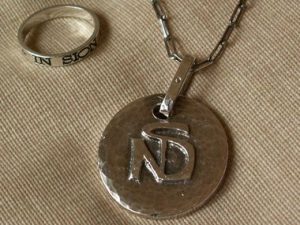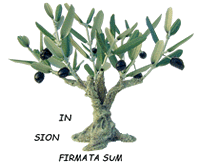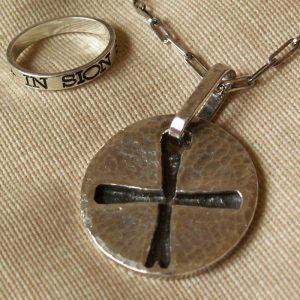In reflecting on the congregation’s need for new symbols, the 1981 general chapter chose two that correspond well with Fr. Theodore’s thinking:
- a Marian sign: on our ring, which is a symbol of our commitment both in the biblical and in the personal sense, is written: IN SION FIRMATA SUM, words of Scripture, which the Church applies to Mary;
- a Christological sign: a simple cross of “glory” in conformity with the theology of the Second Vatican Council and of the early Church, with NDS, which indicates the congregation’s name.
 The cross we wear now was made in Lyon of a resistant silver alloy. The artist, Daniel DARNAS, who specializes in religious art, carefully studied who we are as a congregation and created an object, the elements of which all mean something to us:
The cross we wear now was made in Lyon of a resistant silver alloy. The artist, Daniel DARNAS, who specializes in religious art, carefully studied who we are as a congregation and created an object, the elements of which all mean something to us:
On the back, the monogram: NDS, our name. If the initials were on the front, “the sign” would be changed to an “insignia” and the wealth of the symbols’ interpretation would be lost.
The name on the back marks our appropriation, the incarnation in us. This name, Notre Dame de Sion – Our Lady of Sion – is that of the Virgin Mary.
- The cross is hollow so as to symbolize both the interior reality and the mystery of the “not yet” of God’s promises; we know that “one day, all peoples will call upon the Lord with one heart”, but we do not know when or how this will be.
- The arms of the cross are equal, like in the crosses of the Oriental Churches; they express openness to all peoples, Eastern and Western, Jews and Gentiles.
- The cross without the Christ symbolizes the mystery of death and resurrection, the central mystery of our faith.
- The base of the cross looks like two feet: the human person standing, saved.
The cross is within a circle, symbol of fullness (and a less “shocking” form for the Jewish people).
The hole: the ring that connects us with Christ goes through it; Father Theodore wanted us to be “chained” to Christ.
According to the notes of Sr. Magda, who was in dialogue with the artist and Sr. Kay’s letter no. 53.

